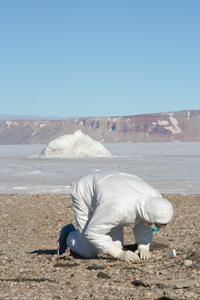Team discovers ancient migration wave from Siberia to the Arctic
LAWRENCE — A team of international researchers, including a University of Kansas anthropological geneticist, has discovered an additional Paleo-Eskimo wave of migration from Siberia into the Arctic region that occurred about 5,000 years ago and was independent of both the Native American and Inuit expansions into the Americas.
 The group's findings are detailed in a research article in the journal Science, to be published Friday, Aug. 29.
The group's findings are detailed in a research article in the journal Science, to be published Friday, Aug. 29.
Michael Crawford, head of KU's Laboratory of Biological Anthropology and a professor of anthropology, said the team of more than 40 researchers collaborated to map the genetic prehistory of the New World Arctic. Present-day Alaska, Canada and Greenland was the one of the last major regions that modern humans populated.
Eske Willerslev, a Danish anthropologist renowned for his work on ancient DNA, headed the study. Willerslev, a Lundbeck Foundation professor from the Centre for GeoGenetics at the University of Copenhagen, asked Crawford, an expert on genetic markers of Siberian human populations, to help examine potential links between genetics of Siberian populations and DNA samples taken from findings in the Arctic.
Crawford said a major key was examining ancient DNA from a large amount of hair taken from a Saqqaq culture Paleo-Eskimo settlement in eastern Greenland. The hair sample was taken from "Saqqaq man," a finding housed at the University of Copenhagen. This research team using new methods was able to map more than 80 percent of the Saqqaq's genome, and using Crawford's DNA data from Siberia and the Aleutian Islands, the team determined the Saqqaq DNA did not resemble the present-day Eskimos or the Na-Dene population, ancestors of most Native Americans.
"You'd expect them to be closest genetically to the neo-Eskimos that are in the region now, but they're not," Crawford said. "That's why we find genetic discontinuity. That was a surprise for all of us. We didn't expect that."
Until recently, past studies had relied mostly on linguistic and morphological data and hypothesized that thousands of years ago three sets of migrations across the Bering Strait, when a land bridge likely existed, into the Americas from Siberia occurred to populate North and South America. Crawford said examining genetic data provides a clearer picture of migratory patterns into the Americas and supports a fourth-wave migration.
"We were able to show that Saqqaq actually was closest genetically to the Koryaks and the Aleuts and different from contemporary Eskimos," Crawford said. "It showed that about 4,000 years ago, there was a separate migration from Siberia, probably from the Chukchi peninsula to Alaska, Canada and Greenland of this Saqqaq culture people, and that this was a separate migration from other Eskimo groups."
According to the team's findings detailed in Science, the Saqqaq Paleo-Eskimo population "likely survived in near isolation for more than 4,000 years, only to vanish around 700 years ago." The study was unable to establish why the disappearance of the Paleo-Eskimo population coincided with ancestors of the Inuit beginning to populate the region.
Still, the recent genomic research settles outstanding issues in Arctic archaeology, including that the Saqqaq Paleo-Eskimo and modern-day Eskimo people are genetically distinct, each with separate origins in eastern Siberia.
Crawford, who led the first foreign anthropological team into Siberia in 1989 after the breakup of the Soviet Union, said the genetic data are key in helping understand the how humans populated the world and can lead to helpful discoveries in the medical realm. For example, knowing a person's genetic history and taking into account the environment of a person's ancestors can determine what type of medical treatment would be best for certain diseases, he said.
Crawford said the project overall demonstrates the value of a multidisciplinary research team's collaboration among people with a wide range of skills, especially when examining ancient migration patterns. The more than 40 collaborators included Dennis O'Rourke, an anthropology professor at the University of Utah and a KU alumnus.
"It took a tremendous amount of work to document this, and a large number of people with different specialties from geology to archaeology to DNA sequencing to isotopic analysis and radio-carbon dating," Crawford said. "Nobody can do it all, and this is why it takes a large team to solve this problem."
Photo: A researcher with the Centre for GeoGenetics at the Natural History Museum of Denmark looks for ancient human remains in northern Greenland. Using genetic studies on findings in Greenland, the international research team, which included KU Anthropology Professor Michael Crawford, discovered a new wave of migration from Siberia into the Arctic about 5,000 years ago. Credit: Claus Andreasen.